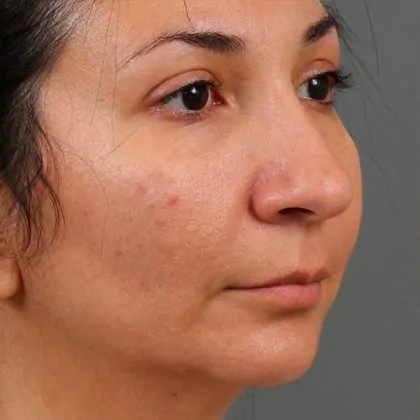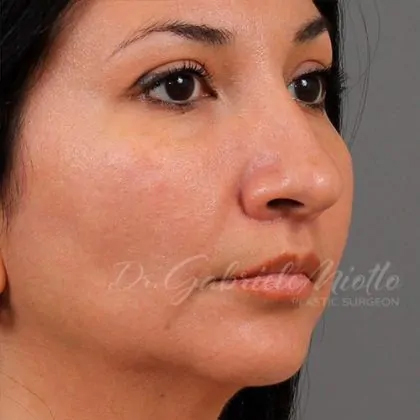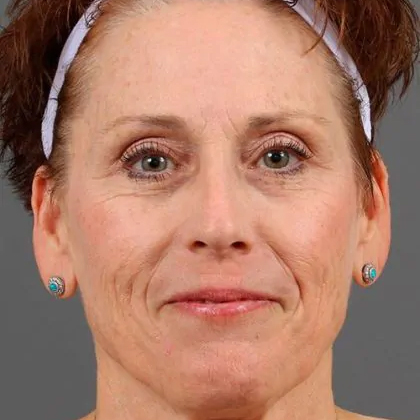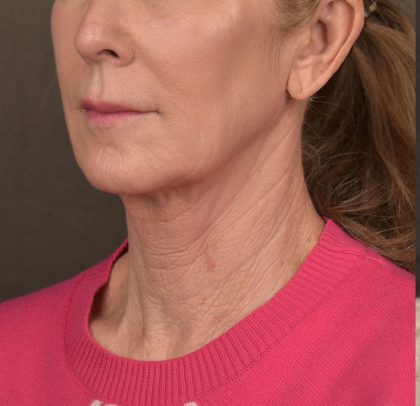Neck Lift
Conveniently located to serve the areas of Atlanta, GA
Dr. Miotto is recognized as one of the top facial rejuvenation specialists in the country, known for her refined techniques, personalized approach, and natural-looking results. Her dedication to excellence has made her a trusted name in advanced facelift procedures.
Learn more about our signature procedure on the Facelift Atlanta page.

A neck lift is a surgical procedure designed to remove excess tissue from the neck to create a more youthful appearance. A neck lift, or cervicoplasty, can address signs of aging in the neck, and is often paired with a facelift to effectively reduce the jowls and sagging of the lower face. This procedure is ideal for patients who have sagging neck skin, weakened neck muscles (platysma laxity), or a “double chin” from excessive deep neck tissue.
At ME Plastic Surgery in Atlanta, Dr. Gabriele Miotto performs neck lifts with or without deep neck work (removal of deep fat, trimming of submandibular glands) depending on the patient’s anatomy. During a neck lift, Dr. Miotto can tighten the muscles in the neck and improve neck banding, remove excess skin, address the jowls that develop along the jawline, and reduce a double chin by trimming the excess fat and deep neck volume. Following a necklift, patients can enjoy a more youthful-looking neck, and a sharper jawline. Many patients state that they are more confident in their appearance after their procedure.
If you would like to explore how you can benefit from a customized neck lift procedure, then schedule a consultation with Dr. Miotto today.
Please do not hesitate to call our Atlanta office at (404) 850-5851 and get the information you need.
Follow Dr. Miotto on Instagram to stay up to date with her latest treatments: @drmiotto.
Contents
Before and After Photos
About Neck Lifts
Due to the natural processes of aging, it is normal to lose tightness and smoothness in the neck region. This is due to the aging of not only the skin, but also the underlying muscles and ligaments along the jawline and throughout the neck. Patients may develop what is colloquially known as a “turkey neck,” or they may become more likely to develop a double chin from accumulated deep neck fat or large submandibular glands. (1)
A neck lift, or a deep neck lift are long-lasting solutions that improve the signs of aging in the neck region and provide better jawline contouring. Dr. Miotto performs neck lifts and facelifts with precise techniques that enhance an individual’s natural beauty. She takes great care to maintain harmony across the patient’s features.
Benefits
Some of the benefits our patients regularly see with a neck lift include:
- Boosted confidence: Many patients report increased self-esteem after a neck lift.
- More youthful appearance: A neck lift can contribute to a more youthful, vibrant look by reducing sagging skin and neck folds.
- Enhanced profile: The procedure defines the jawline and improves overall profile aesthetics.
- Reduced “turkey neck”: Sagging skin and muscle banding along the neck are dramatically reduced.
- Reduction of fat deposits: Excess fat beneath the chin can be removed to reduce a double chin, if necessary.
- Tighter skin: The surgery tightens and lifts loose skin, making for a smoother appearance.
- Long-lasting results: Neck lifts typically yield long-lasting outcomes, with many patients enjoying their enhancements for years.
- Minimal scarring: Incisions are strategically placed to ensure scarring remains hidden and as imperceptible as possible.
Candidates
Candidates for a neck lift are those who are:
- Healthy individuals with relatively good skin quality
- Self-conscious about the appearance of their jawline and neck
- Patients with a healthy lifestyle and stable weight
- Nonsmokers
- Able to maintain realistic expectations for the outcome of their procedure
- Willing to closely follow the preparation and recovery instructions provided by Dr. Miotto and her team.
Personal Consultation
At ME Plastic Surgery, transparency and patient comfort is extremely important to us. Dr. Miotto is always happy to answer their patient’s questions during a personal consultation. At this appointment, Dr. Miotto will encourage you to share your reasons for considering a neck lift, and what you hope to achieve with the procedure. She will also consider the medications and supplements you take regularly, inquire about any allergies, and discuss your overall health. She will examine your face and neck and develop a customized treatment plan that will help you achieve your goals.
Preparation
Dr. Miotto will include specific preparation instructions for you in your unique treatment plan. Patients should avoid any blood-thinning medications like aspirin, ibuprofen, and others for 10 days before their procedure. This also includes drinking alcohol and taking supplements like vitamin E and others. Dr Miotto does not operate on smokers due to known issues with healing. Patients who smoke should quit smoking at least 3 months before their procedure, and they should avoid any nicotine consumption throughout their recovery as well. If patients continue smoking after surgery, the results are not reliable since smoking accelerates facial aging. Dr Miotto and team will schedule 2 separate appointments to go over every detail of your upcoming surgery and instruct you on preop medications and healing supplements.
Procedure
During a neck lift, Dr. Miotto removes bulging fat deposits, tightens the platysma bands and neck muscles, and removes excess skin. (1) For many patients, Dr Miotto also trims the submandibular glands and the digastric muscles to create a better profile, especially in genetically “heavy necks”. Following a neck lift, patients enjoy a redefined jawline and a more youthful-looking neck. Each patient is unique, so the recommendations made during the initial consultation depend on the anatomy and specific needs of a particular patient.
A neck lift is usually performed while the patient is fully asleep (i.e., general anesthesia).
Dr. Miotto performs manual fat removal from the neck–the removal technique she uses also depends on the location of the fat. When fat is located above the platysma muscle, liposuction may be used to remove it. However, when the fat is underneath the platysma muscle, it is surrounded by fibrous tissue, which requires manual removal. (2)
The separation of the platysma muscle causes two broad bands to form on each side of the neck. As time passes, this muscle stretches and hangs against the skin, which creates rope-like vertical bands, blunting the jawline. Dr. Miotto addresses neckbands by shaping the muscle and sewing each side of the platysma muscle together (platysmaplasty). (2) The incision for a neck lift usually starts under the chin, but also around the ear (around the tragus in front and in the fold in the back of the ear), ending in the hairline. The incisions are closed with fine sutures in hidden areas, so the scars are hardly visible.
Recovery
After the procedure, there will be some bruising and swelling. Most neck lift patients can return to work about 2 weeks after their procedure. However, those with more physically demanding occupations may need to wait a little longer to resume normal activities. You will have follow-up appointments scheduled for a few days after the surgery and also for the following weeks after your procedure, when Dr. Miotto and her team will monitor your healing.
You must have a responsible adult to transport you home and stay with you for at least 24 hours after your surgery. You will need help at home for a week or two after surgery, and should plan to have a supportive person with you during your healing time. The medications used during the procedure directly affect the nervous system, and for your safety, we will not allow you to drive or be home alone after the surgery.
Results

The true results of a neck lift may take several months to become apparent. However, after 6 months, patients can expect their results to be stable. There may be slight changes in inflammation and healing which may continue for up to a year. Once you have healed fully from your neck lift, you will see a stronger, sharper jawline and a smoother, more youthful-looking neck. Neck lifts have high patient satisfaction rates.
Corresponding & Complementary Procedures
Many of the individuals who decide to have a necklift choose to have other procedures performed during the same surgical session. Some of the most common procedures included in a neck lift treatment include:
- Lip lift: Used to modify the appearance of the lips by reshaping, shortening the space between the upper lip and the nose, addressing a long upper lip as well as down-turned corners of the mouth. When the face is at rest, down-turned corners make an individual look as if he or she is frowning. A lip lift also improves the appearance of the upper teeth, making the lips and mouth look younger.
- Eyelid lift: Also known as blepharoplasty, this procedure is performed to lift droopy eyelids and correct excess eyelid skin and muscle.
- Deep Plane Facelift: For many patients, a facelift surgery is also needed at the time of a necklift especially if the patient has visible jowls and facial laxity. (3,4)
- Brow lift: A temple brow lift, an endobrow lift or a brow shaping addresses the brow aesthetics and improves that lateral hooding from droopy brows, but also enhances the upper face aesthetics. It is often done with a face and neck lift to reshape the brows and open up the eyes, making the final results more cohesive and natural.
Many patients will include other non-surgical rejuvenation treatments in their procedure as well. Laser skin resurfacing, chemical peels, microneedling, exosomes, and more can all help to rejuvenate the face and boost the results of a neck lift.
FAQ
How painful is a neck lift?
Recovery is usually more intense in the first week after surgery, when there is always visible swelling and bruising. Patients do feel some tightness and soreness in the operated areas for 1-2 weeks. Patients receive medications and recovery instructions to help make this initial healing phase as good and seamless as possible.
Will I have visible scars after a neck lift?
The scars for a neck lift are well-hidden under the chin and around the ear. They are more prominent right after surgery and for a few weeks. There are visible sutures for up to 2 weeks after surgery. Initially the incisions look red and puffy, and after three to four months, the incisions start to fade into skin color.
Do I need to have a complete facelift if I just want a neck lift?
Not necessarily. What determines that is how much lower face laxity also exists. For younger patients, it is possible to have only a neck lift without a facelift. It depends on the patient’s anatomy, but a neck lift without a facelift is performed mostly for young patients with no jowls or facial skin laxity. Some patients would benefit more from a complete facelift if they also have significant aging in the cheeks, deep creases in the face, and heavy jowls.
How long is the recovery after a neck lift?
The most intense downtime happens in the first 2 weeks after surgery when the patients typically have some degree of bruising and swelling at the front and sides of the neck and lower face. Patients might also have bruises around the ear and along the jawline, and there will be visible sutures for up to 2 weeks after surgery. When you meet with Dr. Miotto to discuss your treatment, you will receive a price quote. We also offer financing options for your consideration. If you have any questions about payment plans, pricing, procedures, or more, please call our Atlanta office at (404) 850-5851. Our helpful staff will be happy to assist you!
References
- Pérez P, Hohman MH. Neck Rejuvenation. PubMed. Published 2021. https://www.ncbi.nlm.nih.gov/books/NBK562229/
- Parsa FD, Castel N, Parsa NN. A Modified, Direct Neck Lift Technique: The Cervical Wave-Plasty. Archives of Plastic Surgery. 2016;43(2):181-188. doi:https://doi.org/10.5999/aps.2016.43.2.181
- Jacono AA, Bryant LM, Ahmedli NN. A Novel Extended Deep Plane Facelift Technique for Jawline Rejuvenation and Volumization. Aesthet Surg J. 2019 Nov 13;39(12):1265-1281. doi: 10.1093/asj/sjy292.
- Roskies M, Bray D, Gordon NA, Gualdi A, Nayak LM, Talei B. Limited Delamination Modifications to the Extended Deep Plane Rhytidectomy: An Anatomical Basis for Improved Outcomes. Facial Plast Surg Aesthet Med. 2024 Nov-Dec;26(6):657-664. doi: 10.1089/fpsam.2024.0018. Epub 2024 Jul 29. 10.1089/fpsam.2024.0018













